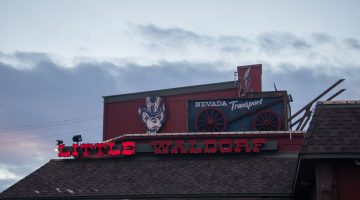By Kaitlin Oki

Any beef or lamb products purchased from Wolf Pack Meats are raised across the street where the cattle consume a strictly grass-fed diet, resulting in an all-natural, leaner, healthier, low-cholesterol product.
Breanna Denney/Nevada Sagebrush
I think cows are cute. I think they taste great too — especially when diced into half-inch cubes of tri-tip alongside some garlic butter-sautéed lobster and rolled up into Reef Sushi’s legendary Surf & Turf dinner roll. Mmm — OK. I’m done with the food porn.
Fellow carnivores, now that we’ve clarified that I’m not going to waste the next 1,800 words attempting to turn you into a vegan animal-rights activist, let’s get down to the meat and potatoes — minus the potatoes.
Last Thursday, you likely mingled among friends and family, casually snacking on appetizers, expanding your gut in preparation to gobble up that perfect golden Thanksgiving turkey, rack of lamb, mouth-watering hunk of honey-glazed ham, top sirloin steak or all of the above. Even I tend to throw caution to the wind and get ready to chow down on this feasting holiday. However, this particular year, as I admired the two turkeys keeping warm in the oven, I couldn’t help speculating about their journeys to my father’s dining table.
I initially stumbled upon Wolf Pack Meats earlier this fall while attending the College of Agriculture, Biotechnology and Natural Resources (CABNR) annual field day at the Main Station Field Lab, located off South McCarran Boulevard in Sparks. Two months later, I found myself gawking in bewilderment at an array of sides of beef and lamb hanging from the ceiling of a 36 F meat locker located in the center of Wolf Pack Meats’ abattoir.
I guess we all come to the understanding at a young age that steak and hamburger are processed slabs of cow. But perhaps there are reasons for certain vocabulary distinctions between meat in its animal and dinner plate forms — in this case, cow versus beef — or phrasing such as “beef comes from cows” instead of “beef is cow.”
Regardless, any mental barrier I had constructed between the adorable, mooing quadrupeds and the Little Nugget’s Awful Awful burger was instantly bulldozed to the ground. These were cows hanging upside-down from the ceiling. Albeit, the carcasses had been decapitated, de-hooved, stripped of their hides, gutted, bifurcated and trimmed — in that order. Nevertheless, the enormous bodies of intact muscle and bone suspended by chains were undeniably cows, cooling and drying within the spacious meat locker in preparation to be separated into hundreds of vacuum-sealed packages and sold around Northern Nevada and California.
A tour of the harvest floor in operation last November politely swept up any remnants of this mental barrier. Talk about farm-to-fork! I will admit: in the days leading up to my tour, my nerves began to get the best of me. A variety of preconceived notions agitated my mind, and I made a point not to eat a particularly large breakfast that morning — just in case.
Curiously, the atmosphere astonished me most of all. I couldn’t tell you exactly what I had been anticipating, but I think the outdated term “slaughterhouse” had tainted my expectations. However, after donning rubber boots, a white coat and an aquamarine hair net, I entered the harvest floor and was greeted by a handful of humble workers intently focused on the work before them.
James “Jim” Salas, a research associate at Wolf Pack Meats, eagerly explained the various processes as each animal moved down the rail. Gesturing toward the far corner of the harvest floor, Salas warned, “Here in a minute, you’re gonna hear Mike say ‘noise.’ That means he’s getting ready to shoot one.”
The plant manager, Charles “Mike” Holcomb, stood above a confined, cement-enclosed holding area, aiming a .22-calliber rifle downward. A moment later, a black cow rolled out of the holding area soundlessly, and a worker wrapped a thick chain around the animal’s hocks.
I initially believed “harvest floor” was simply a euphemism for “kill floor.” Yet, I very shortly came to realize that the act of killing the animals only accounts for a trivial part of the larger process: harvesting the meat — the parts you plan on taking home. It’s only appropriate.
I followed the remainder of the process along the rail. Suspended upside-down, the animal is bled out from the neck. The head is removed and examined by a U.S. Department of Agriculture (USDA) consumer safety inspector to verify that the animal is fit for human consumption. Subsequently, the hide, hooves and internal organs are removed from each carcass. The consumer safety inspector likewise examines the internal organs. From there, an electric blade divides the carcass through the spine into two halves, and the workers proceed to hand-trim off unnecessary fat. Finally, each side is cleansed with 180 F water and a diluted vinegar solution, weighed and stored in the meat locker until it is processed and packaged in the next room according to clientele specifications.
As the only USDA-approved, “one-stop shop” in the state of Nevada, Wolf Pack Meats provides a unique and equally essential service to local ranchers as far north as the Oregon border and as far south as Santa Barbara, Calif. Although USDA-approved harvesting facilities exist in the area, these facilities do not provide processing services; harvested products must be transported to processing plants, thereby increasing the risk of contamination.
Although I’ve found myself questioning most food on my plate since viewing the likes of documentaries “Food, Inc.” and “King Corn,” my life is beginning to feel a bit more like a “Portlandia” skit since my time spent at Wolf Pack Meats. Awareness complicates things…like lunch. And as of right now, the answers aren’t exactly easy to track down. But hey, ignorance isn’t bliss, but rather, nausea and diarrhea.
“Some people don’t want to know,” Salas laughed. “They want to eat it, but they don’t want to know where it came from. They think it tastes great; [they] just don’t want to see it.”
If all food were guaranteed safe and responsible, my quandary with the food industry probably would not exist. I love that I can go out and stuff my face with as much sushi as I can stomach for $25. I’m not guilt free when it comes to understanding the origins of my food. I often overlook the magnificence of a bell pepper that isn’t in season within 500 miles, and then I complain about the 87 cents I spent on it when I find it molding in the bottom of the vegetable drawer. In some ways, I am just as disconnected from my food as the average American. It is especially difficult as a college student when a single shopping trip to Whole Foods can equate to an entire college credit.
But if Thanksgiving were celebrated globally, everyone outside of the United States would have spent significantly more of their disposable income per capita to place an equivalent amount of food on the table — if they even could. Some of them would have hunted and slaughtered their own meats. Others would have handpicked all the vegetables from their own farms instead of the produce aisle at Raley’s. And yet, many of us probably silently rushed the saying of grace as we ogled the bowl of stuffing rather than truly expressed our gratitude for the quantity, quality, convenience and price of the feast.
Judging by the prices stamped on the steaks in the retail fridge at Wolf Pack Meats, convincing students to reconsider the frozen clump of Great Value hamburger from Wal-Mart isn’t so simple. But there are definitive reasons that account for the fiscal differences between Wal-Mart and Wolf Pack Meats.
Within the United States, four major corporations dominate approximately 81 percent of the meat packing industry: Tyson Foods, Cargill Meat Solutions Corp., JBS USA and National Beef Packing Co., LLC. Never mind the mom-and-pop farm these days (which still exist); these are industries that reduce consumer costs via industrial techniques, likened to “factories” by critics.
If you are paying attention, it becomes increasingly difficult to be confident in what you’re swallowing. A lot of hype surrounds the concept of “mystery meat,” from factory farming and genetically modified organisms to added hormones and antibiotics. If you’re really curious about these accusations, visit Meat.org (“the website the meat industry doesn’t want you to see”) or watch “Food, Inc.,” which dedicated much of its monetary success to battling lawsuits filed against the documentary’s director, Robert Kenner, following its release.
Or simply take a short drive out to Sparks to visit the Wolf Pack Meats abattoir nestled in amongst open fields of grazing cattle and sheep on Clean Water Way. Better yet, call ahead and arrange a facilities tour with Mike Holcomb, who will gladly show you around and answer any questions. Not only will you notice the sanitary conditions, content animals and state-of-the-art equipment, but also the openness and sincerity of the business and its staff. Unlike an undercover People for the Ethical Treatment of Animals (PETA) investigation of Tyson Foods, you get the impression that these guys have nothing to hide and everything to share.
Salas recounted a story of a woman who ordered a side of beef and asked, “Can you make that all tri-tip?” Well, if you don’t know, there’s only one tri-tip cut on a side of a cow.
“A lot of people don’t know where their meat comes from,” Salas said. “I’d like to see a little bit more education because people need to know. I get a lot of people in here who don’t know.”
Keith Wemple, a research associate at Wolf Pack Meats, even went so far as to suggest that meat sciences should be included in the university’s core curriculum.

Keith Wemple, a research associate at Wolf Pack Meats, aspires for more educational involvement with CABNR and the wider community, stressing safe food-handling protocol, the origins of your food and embracing personal responsibility when it comes to knowing your food.
Benjamin Hirsch/Nevada Sagebrush
“The whole process should be part of anyone’s education,” Wemple said. “We’re not educating people, so therefore we have to have this government that people think needs to protect them when we should be teaching the basics…proper food handling, how to cook it, taking the fear away from (the meat industry).”
Until five years ago, Wolf Pack Meats hosted meat science classes on site for credit in partnership with CABNR. But with state budget cuts, the educational aspect of Wolf Pack Meats has since been reduced to public tours, a partnership with the University of Nevada Cooperative Extension’s Herds & Harvest certification program and periodic involvement in the agricultural science and pre-veterinary programs offered at the university.
On the upside, however, Wolf Pack Meats’ recent deviation from education has had its advantages.
“We’ve gained so much — helping the local producers take care of their products so they can make a living off of it so they can turn around and resell it here locally,” Holcomb said. “This whole local farm movement is huge right now. If we weren’t here, there’s a lot of those people that would not be in business right now because there just isn’t anywhere else to go to.”
Perusing farmers markets and locally owned grocery stores across Nevada and Northern California (such as the Great Basin Community Food Co-op in downtown Reno), it’s not unlikely that you’ll find an affordable, lean, grass-fed, tightly trimmed, added hormone/antibiotic-free, custom cut of meat stamped with the Wolf Pack Meats trademark.
Ranchers are on waiting lists to send their animals in. Customers typically buy everything out of the retail fridge on a weekly basis. Something leads me to believe that Wolf Pack Meats must be doing something right. Walking down the driveway past grazing cattle, shaking hands with the family-like staff, catching your breath at the awesome sight of eight feet of cow muscle — it all gives you confidence, washing away the fears of mistreatment of an animal or employee, mystery meat infused with pink slime or 100,000 cows in one burger.
“They trust it,” Holcomb said in regards to his customers.
And if there’s anything you should know and trust, it’s your food.
Kaitlin Oki can be reached at koki@http://archive.archive.nevadasagebrush.com.











